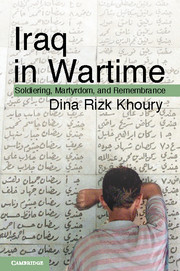Book contents
- Frontmatter
- Contents
- List of Illustrations, Maps, and Table
- Acknowledgments
- Note on Translations and Transliteration
- Maps
- 1 Introduction
- 2 Iraq’s Wars under the Ba‘th
- 3 The Internal Front
- 4 Battlefronts
- 5 Things Fall Apart
- 6 War’s Citizens, War’s Families
- 7 Memory for the Future
- 8 Commemorating the Dead
- 9 Postscript
- Appendix I Distribution in Percentage of Ba‘th Party Members, “Friends of Saddam,” and Martyrs in Fifteen Iraqi Provinces, 1998–1999
- Appendix II Percentage of Ba‘th Party Membership among Matriculating Students (Sixth Secondary) in Ten Iraqi Provinces, 1987–1988
- Appendix III Report Issued by Ali Hasan al-Majid, Head of the Northern Bureau of the Ba‘th Party to the General Secretariat, August 1987
- Sources and Bibliography
- Index
- References
8 - Commemorating the Dead
Published online by Cambridge University Press: 05 March 2013
- Frontmatter
- Contents
- List of Illustrations, Maps, and Table
- Acknowledgments
- Note on Translations and Transliteration
- Maps
- 1 Introduction
- 2 Iraq’s Wars under the Ba‘th
- 3 The Internal Front
- 4 Battlefronts
- 5 Things Fall Apart
- 6 War’s Citizens, War’s Families
- 7 Memory for the Future
- 8 Commemorating the Dead
- 9 Postscript
- Appendix I Distribution in Percentage of Ba‘th Party Members, “Friends of Saddam,” and Martyrs in Fifteen Iraqi Provinces, 1998–1999
- Appendix II Percentage of Ba‘th Party Membership among Matriculating Students (Sixth Secondary) in Ten Iraqi Provinces, 1987–1988
- Appendix III Report Issued by Ali Hasan al-Majid, Head of the Northern Bureau of the Ba‘th Party to the General Secretariat, August 1987
- Sources and Bibliography
- Index
- References
Summary
On February 16, 1981, the mayor of Baghdad, Samir Abd al-Wahab al-Shaykhli, made public the government’s intention to build a $40 million monument commemorating the dead of the Iran-Iraq war. Conceived by artist Isma‘il Fattah al-Turk and drafted by a team of architects from the Baghdad School of Architecture, the monument consisted “of a circular platform, 190 meter in diameter, floating over an underground museum and carrying a 40-meter high split dome.” Set in the middle of an artificial lake, the monument stood apart from the city’s high rises and bustle, and was meant to create a space for reflection on the meaning of death. The Martyr’s Monument signaled the intention of the state to offer a distinct place to those martyred in the war with Iran. It distinguished them from martyrs for the nation among the armed forces and from the Ba‘th Party who had come before them. The Martyr’s Monument, officially titled the Monument of the Martyrs of Qadisiyat Saddam, commemorated the death of citizen soldiers in the first national war in which mass death became the norm. The government’s goals were to nationalize that death, create rituals that commemorated the fallen, render their deaths acceptable to their families, and do so while controlling the meaning of that loss.
In the first years of the war, cultural institutions in cooperation with the Ba‘th Party undertook a systematic effort to sanctify the deaths of soldiers by developing rituals that gave meaning to their deaths within the narrow confines of a secularized reading of martyrdom in Islam and a Ba‘thist interpretation of Iraqi Arab nationalism. These efforts were centralized and authoritarian. They did not allow for any development of community-based rituals of mourning or the formation of independent organizations of martyrs’ families. Their purpose was to depersonalize and routinize death. Above all, they were designed to foster and project unity of Iraq’s diverse population and bolster national support for the war by highlighting the martyrs’ families’ contributions and the leadership’s generosity.
- Type
- Chapter
- Information
- Iraq in WartimeSoldiering, Martyrdom, and Remembrance, pp. 219 - 244Publisher: Cambridge University PressPrint publication year: 2013



